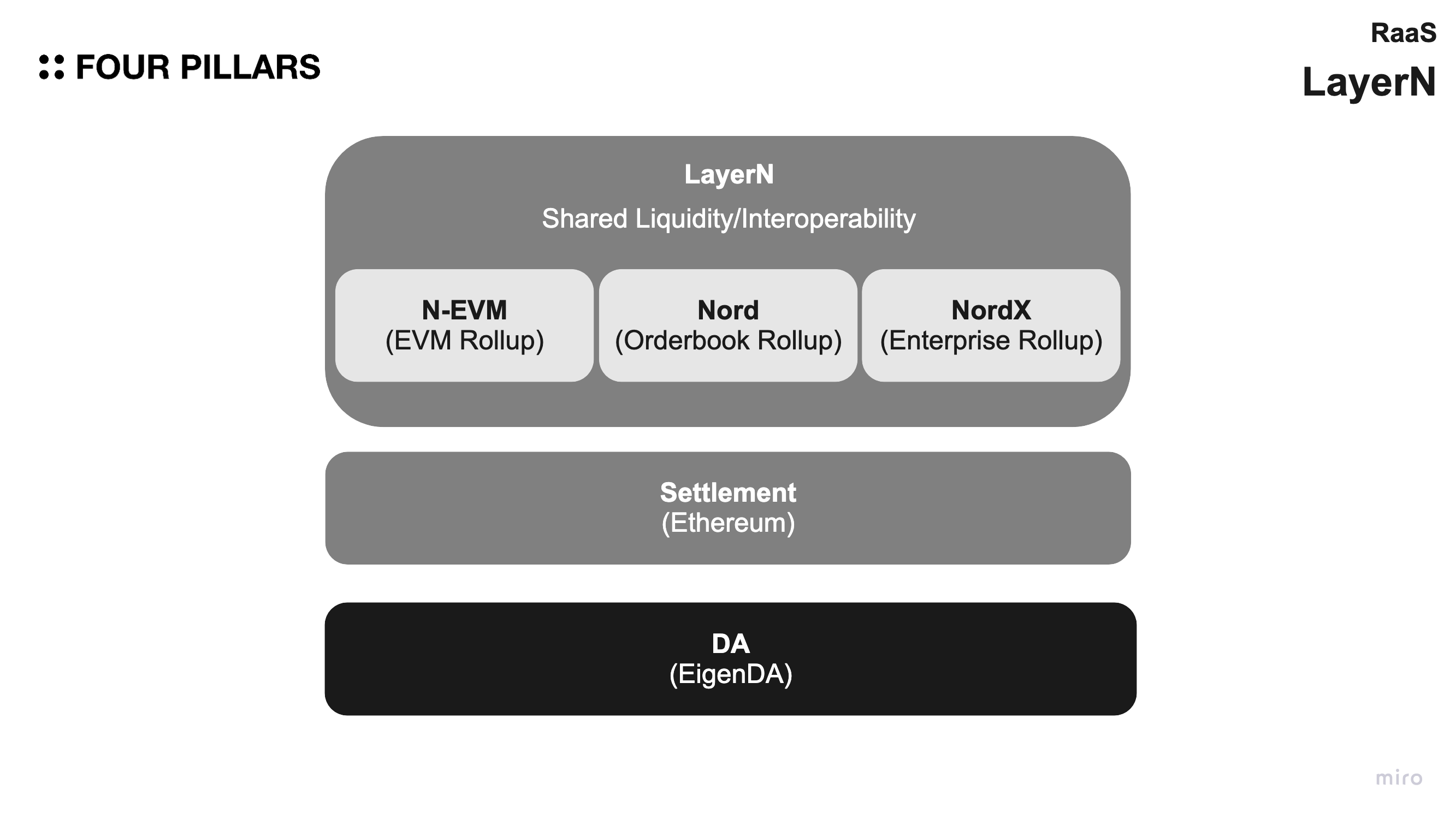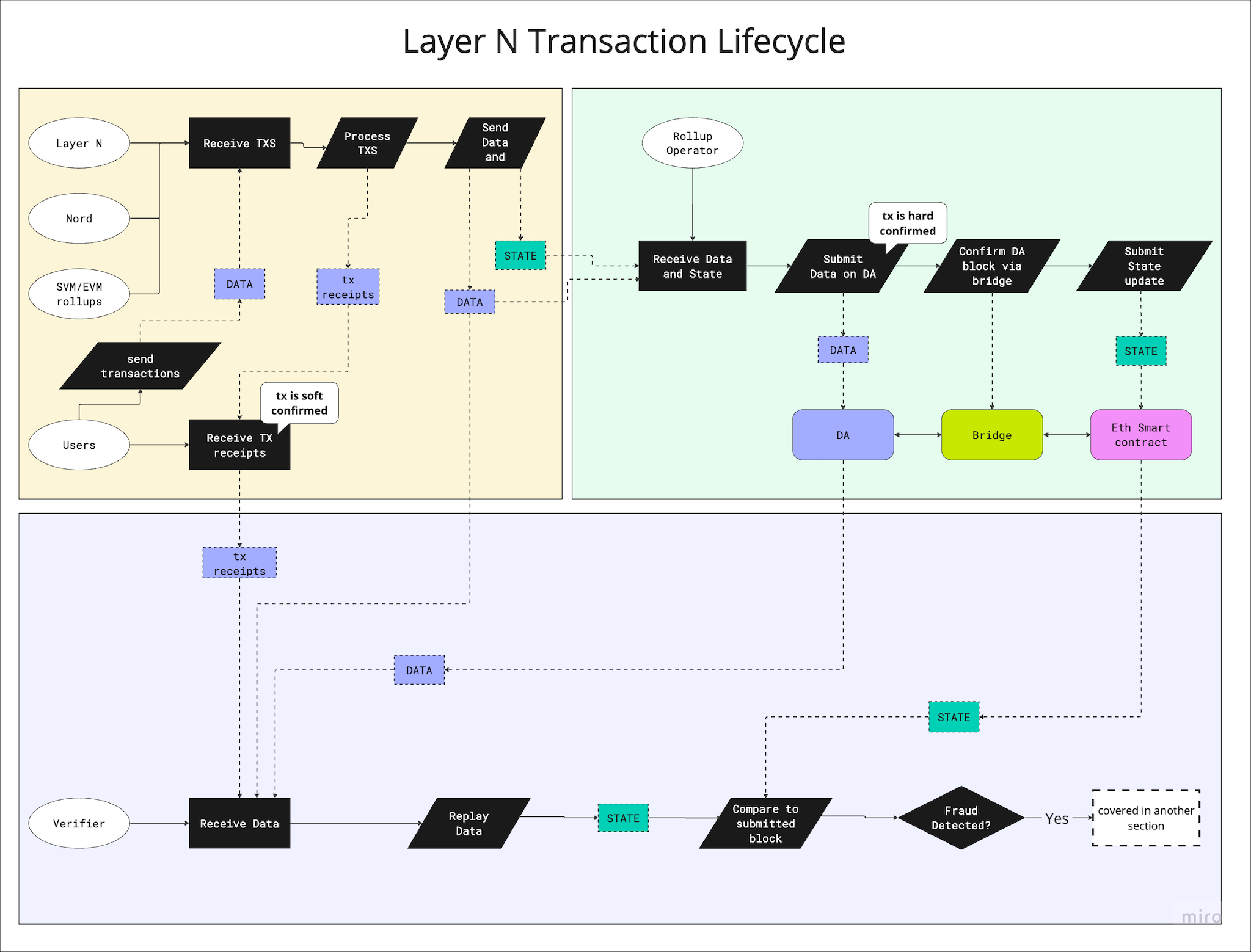LayerN
Key Takeaways
- Layer N is a layer 2 network designed for financial applications on Ethereum, providing high performance, native inter-rollup shared liquidity and communication, and low transaction fees.
- The network includes three major execution environments: N-EVM, Nord, and NordX.
- Layer N introduces a novel shared sequencing solution that enables Inter-Rollup Communication (IRC) within the entire Layer N network, addressing the issue of liquidity fragmentation in the rollup ecosystem.
- Layer N introduces a zero-knowledge based fraud proving system (ZKFP) by leveraging zkRISC-V by RiscZero that is more cost-effective and efficient for end users, solving the inefficiency and unsafety of traditional optimistic rollups' interactive fraud proofs.
1. Overview

Layer N is a layer 2 network that is specifically designed for financial applications on Ethereum. Its purpose is to compete with traditional financial networks. The network is composed of rollup instances that provide high performance, native inter-rollup shared liquidity and communication, and an improved user and developer experience. Applications can be built on Layer N, either in a custom execution environment or on the public EVM instance. The execution latencies are significantly lower, the throughput is higher, and the transaction fees are negligible. Additionally, rollups are fully composable.
2. Execution
LayerN offers three execution environments: N-EVM, which is used for deploying smart contracts, Nord exchange rollup with a custom-built Rust orderbook execution environment, and NordX for enterprise clients.
At a high level, Layer N is a network that accepts transactions directly from users, orders them, executes them, and then batches, compresses, and settles them back to Ethereum. This design allows Layer N to optimize its execution environment and provide significant scaling benefits, all while being secured by Ethereum.
Some Layer N rollups use signature aggregation techniques to compress data by a factor of 8-10 times, resulting in even lower transaction fees. This further reduces Layer N's dependence on expensive block space.
This section will guide you through the typical journey of a transaction submitted to Layer N.

- Transactions on the Layer N network are first ordered on a first-in-first-out basis.
- Ordered transactions are then executed in the virtual machine, after which a transaction receipt is returned to the user. This receipt serves as a soft confirmation that can later be used to submit a fraud proof if the transaction is not correctly included. In most cases, this receipt can be counted as a safe confirmation.
- The data from processed transactions are streamed to Data Availability layers, where they can be made available for verifiers to submit fraud proofs. Once a transaction is posted to the DA layer, it is considered hard-confirmed.
- Once the transaction data for a block is successfully posted to the DA layer, a state update block is posted to Ethereum to finalize the state.
- Verifiers can subscribe to the validator and DA layer for transaction data and replay it to resimulate the state updates.
- Verifiers then compare their own simulated state to the one on-chain to ensure that they match. If the states do not match, the verifier submits a fraud proof.
2.1 Shared Sequencer
Layer N introduces a novel shared sequencing solution that enables Inter-Rollup Communication (IRC) within the entire Layer N network.
Layer N addresses the issue of liquidity fragmentation in the rollup ecosystem by providing a shared sequencer for EVM rollups, enabling native cross-rollup communication without external bridges or wrapped token systems. This eliminates the need for dApps to compromise their performance and functionalities by going cross-chain or drying up liquidity for other dApps on the same chain. The breakthrough unlocks opportunities for DeFi developers and enables DEX protocols to attract market makers without heavy incentivizations, pushing DeFi to provide a superior experience with applications made possible by leveraging composability.
3. Settlement
Layer N introduces a zero-knowledge based fraud proving system (ZKFP) by leveraging zkRISC-V by RiscZero that is more cost-effective and efficient for end users, solving the inefficiency and unsafety of traditional optimistic rollups' interactive fraud proofs.
The process for a verifier to detect and report fraud on Layer N is as follows:
- The verifier replays the state on a local machine after reading transaction-level data that is posted on the data availability layer.
- The verifier detects that the state root update posted to Ethereum does not match the state root obtained from DA replay.
- The verifier calls the fault-proof contract on Ethereum to freeze the deposits and withdrawals on the rollup and posts a significant stake.
- The Ethereum contract initiates a dispute period during which the verifier runs the state simulation on a RISC-V verifiable zero-knowledge virtual machine, which returns a cryptographic receipt as a proof of fraud. We have partnered with RISC Zero to accomplish this.
- The verifier then submits the receipt directly to the on-chain verifier that uses the program hash to verify the proof.
- If this proof is submitted to the contract and it proves fraud, the Ethereum contract goes into state recovery mode.
In the future, using the Bonsai network developed by RISC Zero, Layer N will be able to fully transition from optimistic rollup to zero-knowledge rollup, removing the need for the fraud proof period and offering privacy.
4. Data Availability
EigenDA is used by Layer N as the solution to the high cost of calldata on the Ethereum network. It provides megabytes of blockspace per second, while still maintaining the security of the data through restaking by Ethereum validators. This sets EigenDA apart from other off-chain data availability solutions and mitigates the risk of off-chain data availability.
5. Interoperability
LayerN's vision is to enable seamless interoperability between LayerN-based chains, allowing for shared security and liquidity. To achieve this, they plan to build the Inter-Rollup Communication protocol (IRC), a unified messaging layer that connects all rollup instances. This will enable seamless transmission of messages and instant bridging of liquidity.
LayerN aims to achieve this vision using a shared sequencer.
5.1 Hyperlane
Layer N and Hyperlane are partnering to provide seamless composability for a network of optimized rollups.
Layer N plans to integrate Hyperlane into its EVM and SVM rollups, allowing applications to read and write state to other rollups. For instance, an application deployed natively on the EVM chain can use Layer N's SVM rollup to make an atomic oracle call — a native smart contract API call only available on Layer N. It can then read the results of that call and use them to update its own internal state.
6. Customization
- N-EVM is Layer N's primary public rollup instance, which enables developers to deploy arbitrary smart contracts. It is compatible with EVM.
- Nord is a specialized exchange rollup that features a custom-built, hyper-efficient Rust orderbook execution environment.
- NordX is an institutional product that we offer to enterprise clients.
7. Use Cases
8. Team
- Dima Romanov (Co-Founder)
- David Cao (Co-Founder)
- Sheheryar (CTO)
- Patricia (Head of Growth)
9. Resources
- Website | Docs | Blog | Twitter | Discord
- Seamless Inter-rollup Connectivity by LayerN
- Zero-knowledge Fraud Proofs by LayerN
